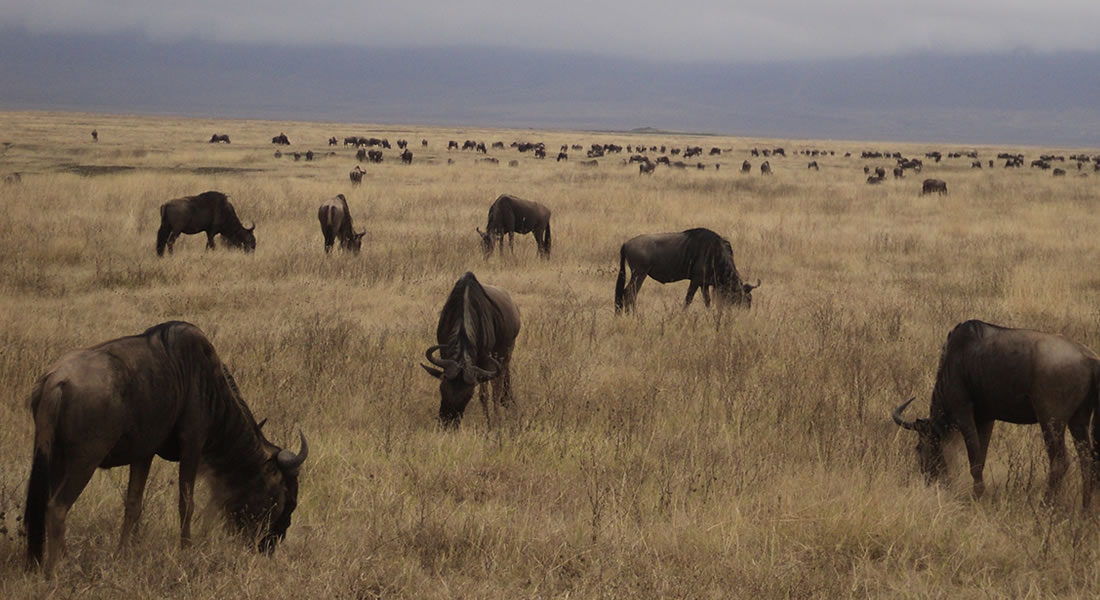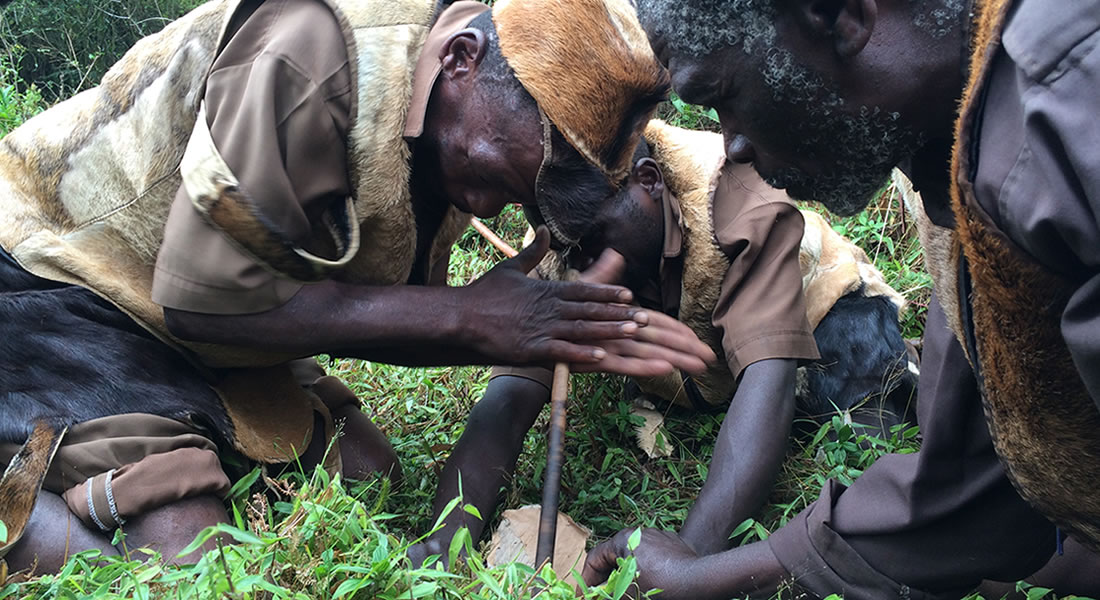Rwanda Gorilla Trekking is undoubtedly one of the most popular vacation activities in Africa since…

Tanzania is one of the major tourist destinations in the the whole of Africa and presents a wide of attractions and unique features that tourists from around the world like to explore throughout the year. Here are 10 best places to visit in Tanzania.
Serengeti National Park
Serengeti National Park aptly embodies the vibrant essence of Africa, offering the world-famous Great Wildebeest Migration, the migration of two million wildebeests, and hundreds of thousands of gazelles and zebras closely stalked by their predators. Just like in the case of Kenya wildlife tours, Tanzanian wildebeest migration is a true spectacle. This, together with the fact that it is home to a variety of animals that are internationally threatened, makes it one of the best safari experiences on the planet. The private Serengeti Safari Camp provides an incredibly personal and raw experience where you become one with the African bush itself. It travels four to five times a year in tandem with the migration. A unique opportunity to experience the charm of an African safari is presented to both calm and tranquil, as well as busy and vibrant. Serengeti National Park lies on the border with Kenya. The park is called the Masai Mara on the Kenyan side. One of the most well-liked safari destinations worldwide is this massive East African conservation reserve. The park is renowned for hosting large-scale animal migrations, such as the over a million wildebeest that come and go within it based on the wet season. The park is one of the greatest places in the world to watch lions up close because it is home to almost 2,500 of them. The best ways to see the park are by guided safari and spending the night in lodges or cabins.
Mount Kilimanjaro
The majestic Mount Kilimanjaro, sometimes referred to as the “roof of Africa,” towers over Tanzania’s enormous expanse of golden grassland. As one of the biggest dormant volcanoes in the world and the tallest peak in Africa, Kilimanjaro National Park offers a striking visual spectacle to the abundant species that inhabits the famous park below. Enjoy this exceptional perspective from the ground, or for those who are more daring, climb Mount Kilimanjaro from the National Park’s eastern side. Accompanied by knowledgeable guides, see the change from lush rainforests to barren wasteland as you go to the summit for expansive vistas. Try the less well-known Rongai Route, which has views across the Kibo crater, or the busier Kili Route. The prodigal mountain of Kilimanjaro, soaring at 5,895 metres, is the highest peak in Africa and the world’s tallest freestanding mountain. This mountain is a component of the renowned Kilimanjaro National Park, which is well-known for its diverse wildlife. As the starting point for some of the most difficult climbing and trekking treks, this mountain is also one of the most well-liked tourism destinations in Tanzania for adventure seekers.
Ngorongoro Conservation Area
The Ngorongoro Conservation Area is a fantastic place to see animals in Tanzania. The biggest complete volcanic crater in the world, the Ngorongoro Crater, is its most notable feature. It is a geological marvel. The world’s greatest concentration of lions may be found inside the crater. There are also a number of black rhinos in the vicinity. In the protection area, one may also frequently observe cheetahs, hyenas, and leopards. Once more, travelling through the Ngorongoro Conservation Area on a guided safari is the ideal option. Wildlife safaris to East Africa often times include the famous Ngorongoro crater. The Ngorongoro Conservation Area is one of the most well-known tourist destinations in Tanzania and is well-known for the Big 5 Game (elephant, lion, leopard, rhinoceros, elephant, and cape buffalo). See the Ngorongoro Crater, which is a volcanic structure, and an enormous zebra and wildebeest migration here if you’d want to add a little adventure to your Tanzanian vacation.
Lake Manyara National Park
Large savannas come to mind when most people think about Tanzania’s national parks. But the view from Lake Manyara National Park is very different. The lake itself is a showpiece, as its name implies. Over one third of the park is comprised of Lake Manyara, however its extent varies throughout the dry season. The lake is a great place to see wildlife because it is a significant water supply. Numerous animals congregate near the lake in search of water during the dry season, which runs from June to September. That means that on a day safari, you will have no trouble spotting these amazing animals. With its varied species and captivating scenery, Tanzania’s Lake Manyara National Park is one of its most stunning national parks and is well worth a visit in 2023. This park, which is home to a variety of species, is situated in northern Tanzania and is made up of woodlands, grasslands, and forests. The renowned tree-climbing lions steal the show, but tourists may also encounter native species during safari drives, such as elephants, giraffes, and baboons. Over 300 different bird species may be seen in Lake Manyara Park, where hundreds of flamingos congregate along the lakeshore during the rainy season.
Olduvai Gorge
A well-liked tourist site in Tanzania, Olduvai Gorge is significant both biologically and historically. Olduvai Gorge, an important anthropological site in the eastern Serengeti region, has fossil deposits of the human lineage that have proven to be a rich source of knowledge for biologists studying the development of humans over the past two million years.
Arusha City
One of the top tourist destinations in Tanzania is the expansive city of Arusha, which is located at the foot of Mount Meru. Because of its position, which makes it a starting point for exciting adventure destinations like Mount Kilimanjaro and Serengeti National Park, Arusha is a significant travel destination. It offers a wide range of luxury safari experiences and is also among the greatest locations to stay in Tanzania because of the calm, moderate environment and vibrant marketplaces. Visits to Shanga, Arusha National Park, the Clock Tower, the National History Museum, the Kilombero Market, and the best cafés in town are among the most well-liked tourist destinations.
Lake Tanganyika
Approximately 2000 different species of fish, plants, crustaceans, and birds may be found in Lake Tanganyika, one of the world’s finest freshwater environments. Of all the fish species, about 500 are unique to Earth, and half of them are cichlid species. As a result, the lake offers a special setting for research on evolution and biodiversity protection. Though it is not tidal, the rich surface water that is constantly moving gives its residents an abundance of plankton, which in turn supplies much-needed protein for both the local and export markets. The continuous movement that prevents bilharzia, a parasite illness borne by shallow-water snails, from spreading is aided by the strong winds that originate from the nearby mountains.
Ruaha National Park
Ruaha, Tanzania’s largest national park, is home to an astounding quantity of giraffes and elephants. In actuality, Giraffe Park is a common name for Ruaha National Park. A safari in Ruaha National Park might be a fantastic option if these elegant creatures are your main focus but you wouldn’t mind seeing the endangered lion as well. Ruaha National Park, which situated in the very centre of Tanzania, is well-liked by tourists for having few people. As a result, your exploration of Tanzania will be more genuine. Ruaha National Park, Tanzania’s largest but least well-known national park, provides a distinctive, private safari experience away from the masses. Equipped with a plethora of lions, elephants, leopards, and wild dogs, this diverse habitat may be explored on foot or during a game drive, offering a large expanse of territory to cover. Located by a river in Ruaha National Park, the luxurious and exclusive Jongomero Camp is a tented camp choice with breathtaking views. Enjoy fly-camping beneath a blanket of stars in the middle of the jungle for a genuine, customised experience.
Selous National Park
Seen as one of the biggest wildlife reserves on Earth and one of the major tourist destinations in East Africa, Selous Game Reserve is a must-see destination in Tanzania. Covering an area of 5,000 square kilometres, this wildlife region is home to approximately 350 species of birds, reptiles, and plants, as well as a wide variety of interesting creatures. Also, this location has well-appointed lodges that allow visitors to spend the night in the reserve’s wildness. The spectacular array of animals found in the park’s meadows, hills, forests, and scrub makes the Selous National Park one of Africa’s major safari destinations. There are plenty of crocodiles and hippopotamuses in the Rufiji River, as well as chances to see leopards and bands of wild dogs. Nestled in the centre of the activity, the exquisitely designed, sophisticated, and refined Sand Rivers Selous resort is situated along the banks of the Rufuji River. Take a bath in the hot springs, go tiger fishing, or simply relax with sundowners and a romantic meal while listening to the plains of Tanzania play out.
Tarangire National Park
Tarangire National Park, Tanzania’s sixth-largest national park, is situated in the Manyara area. Even though it is not as well-known as its equivalents, the Serengeti and Ngorongoro, it is nevertheless one of Tanzania’s best destinations for seeing African species of animals, including zebras, elephants, lions, and more. Luxurious hotels, as well as beautiful tents and cabins inside the park, are available for lodging here. Elephants, giraffes, hyenas, and many more animals may be seen in the park. While you are sleeping, the animals are allowed to wander about your tents; nevertheless, these tented towns are constantly under Maasai watch.



